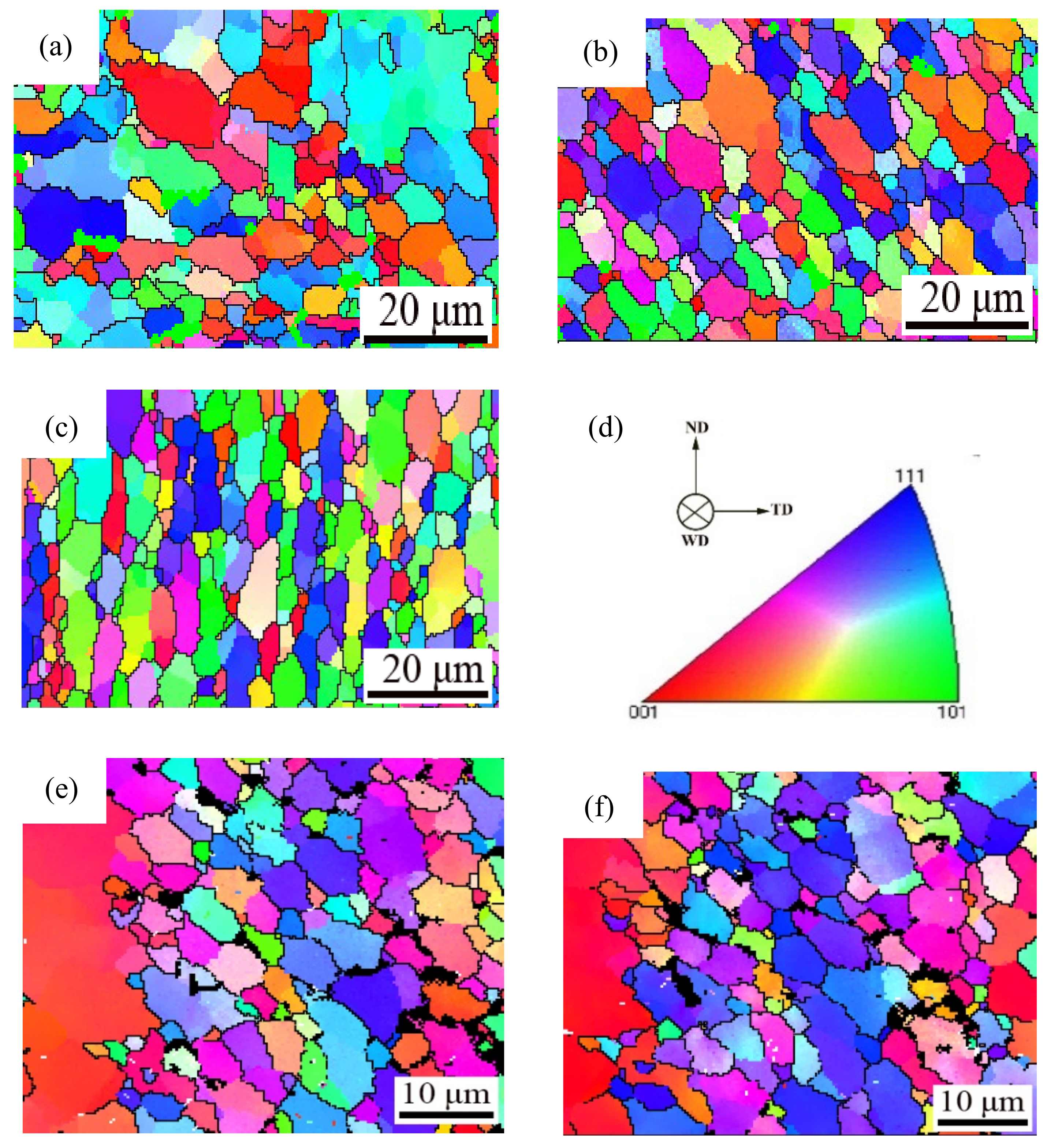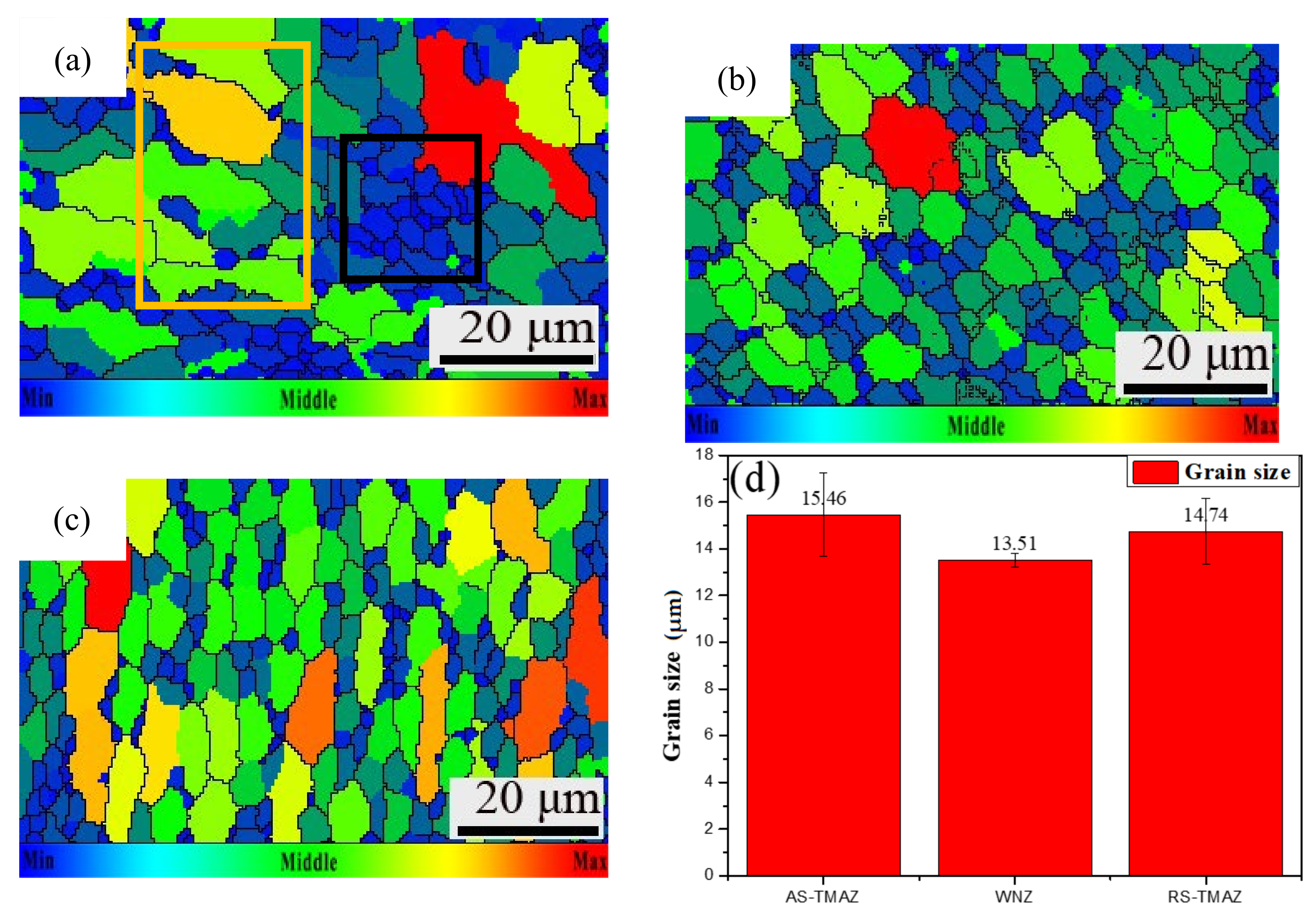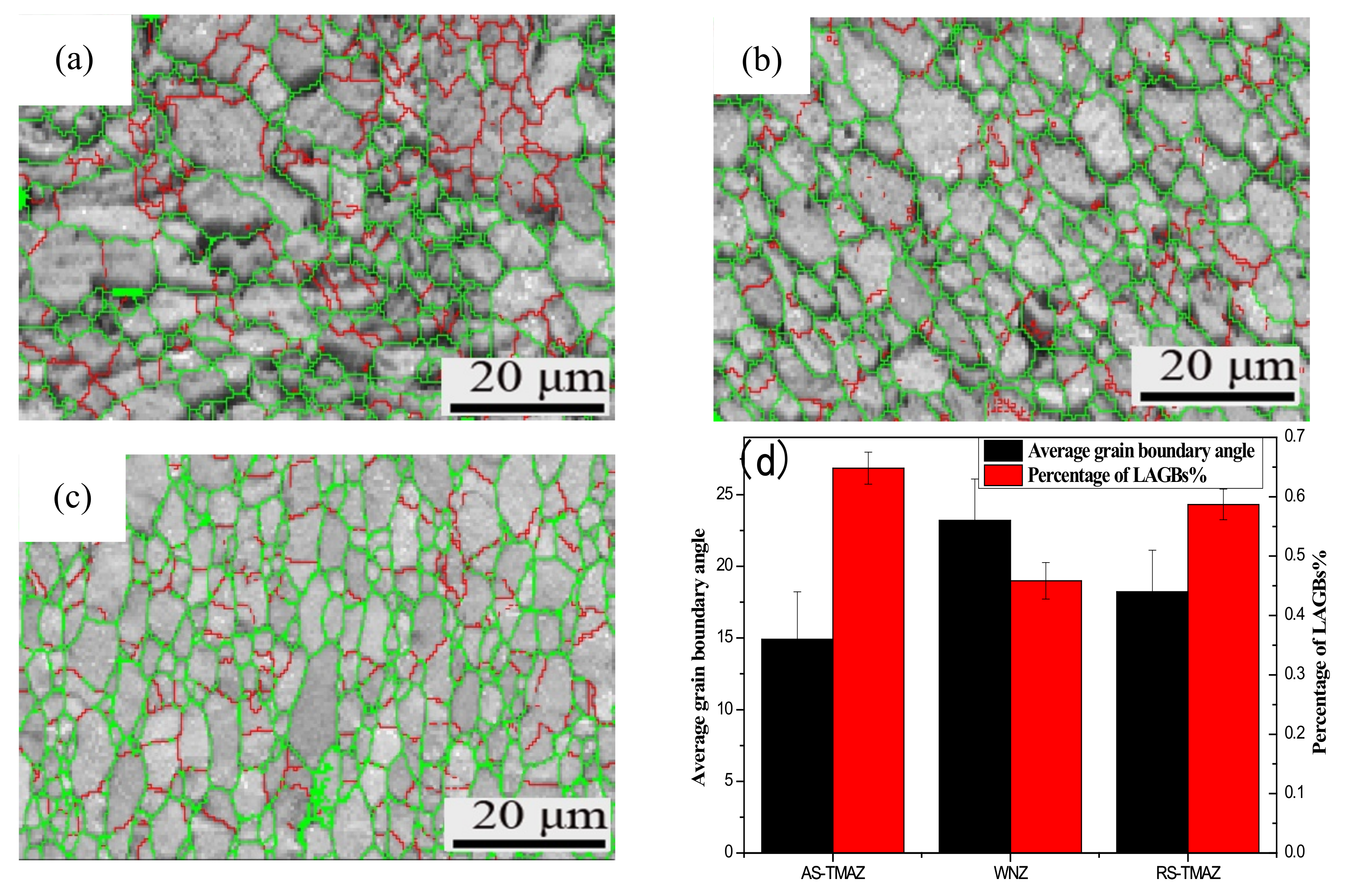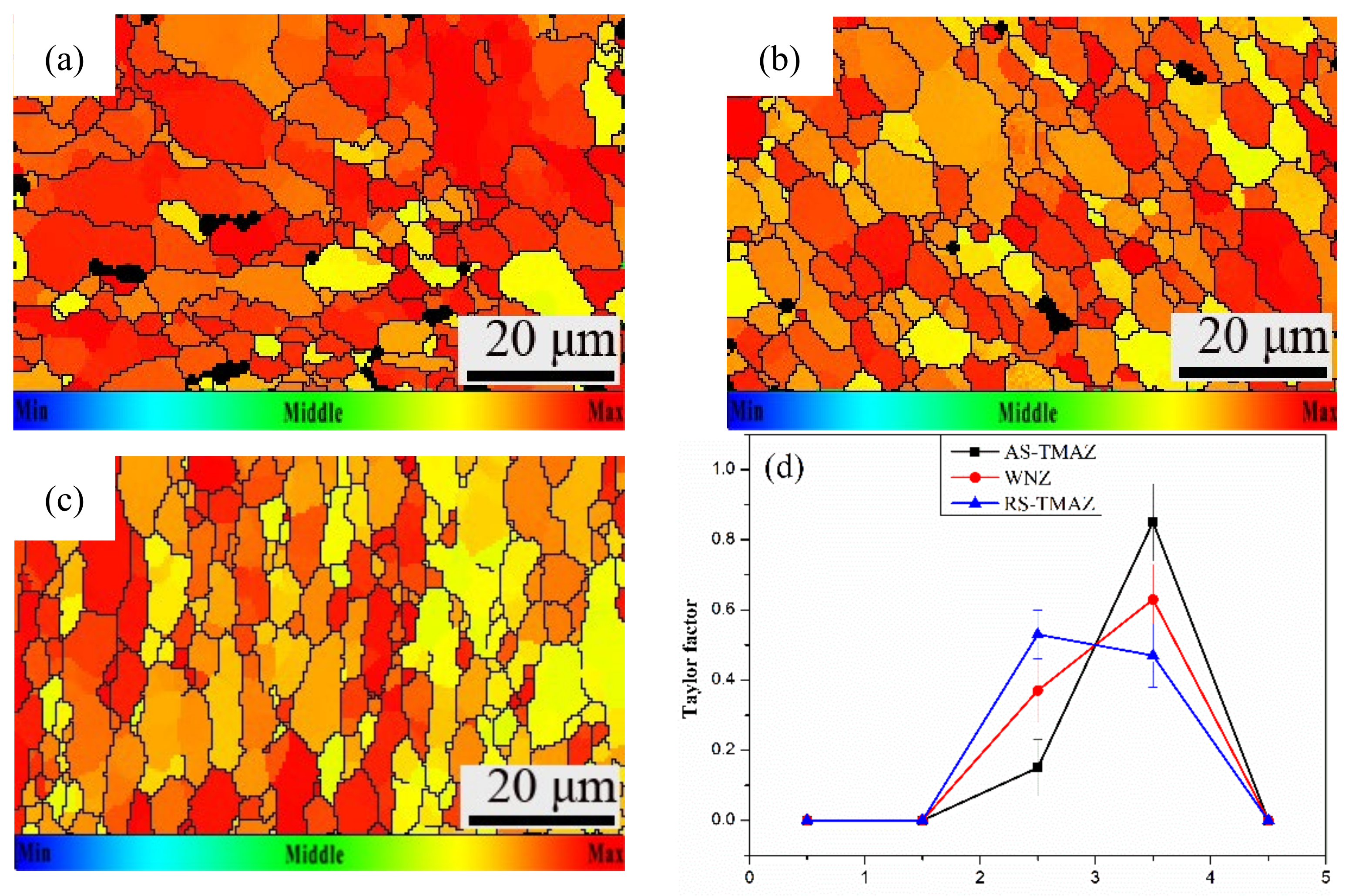EBSD Characterization of the Microstructure of 7A52 Aluminum Alloy Joints Welded by Friction Stir Welding
Abstract
1. Introduction
2. Materials and Experimental
3. Results and Discussion
3.1. Cross Section of Welded Joint
3.2. Fracture
3.3. Grain Orientation
3.4. Grain Shape and Grain Size
3.5. Grain Boundary
3.6. Taylor Factor
3.7. Effect of the Welding Process on Recrystallization Behavior
4. Conclusions
- The 7A52 aluminum alloy FSW fracture is located at the junction of AS-TMAZ–SZ, with many dimples in the it, and it is a ductile fracture.
- The SZ and RS-TMAZ are dominated by < 101 > crystal orientation, the grain size is small, and a low-angle grain boundary accounts for the majority of boundaries, effectively hindering the movement of dislocations. The Taylor factor distribution in the weld nugget zone is relatively uniform. The microstructures of the SZ and RS-TMAZ are uniformly transitioned without stress concentration.
- The AS-TMAZ has serious grain structure deformations. The grain orientation is disorderly, a high-angle grain boundary accounts for a relatively high proportion of boundaries, the Taylor factor has a large difference, and the resistance to external force deformation is poor. Therefore, the abrupt grain structure in the region leads to the uneven transition of the microstructure, and this becomes the weak point of its mechanical properties.
- The TMAZ microstructure is dominated by discontinuous dynamic recrystallization; the SZ accounts for less, but the substructured grain shows an inverse relationship. The degree of recrystallization is mainly controlled by the stirring force in different directions.
Author Contributions
Funding
Institutional Review Board Statement
Informed Consent Statement
Data Availability Statement
Conflicts of Interest
References
- Meng, Y.G.; Xu, J. A review of recent advances in tribology. Friction 2020, 8, 221–300. [Google Scholar]
- Rao, A.C.; Vasu, V. Stress corrosion cracking behaviour of 7xxx aluminum alloys: A literature review. Trans. Nonferrous Met. Soc. China 2016, 26, 1447–1471. [Google Scholar] [CrossRef]
- Liang, J.; Zhang, B.S. A review of selective laser melting of aluminum alloys: Processing, microstructure, property and developing trends. J. Mater. Sci. Technol. 2019, 35, 270–284. [Google Scholar]
- Zhang, Z.; Xiao, B.L.; Ma, Z.Y. Enhancing mechanical properties of friction stir welded 2219Al–T6 joints at high welding speed through water cooling and post-welding artificial ageing. Mater. Charact. 2015, 106, 255–265. [Google Scholar] [CrossRef]
- Zhang, P.; Li, Z. Tensile Properties and Deformation Behaviors of a New Aluminum Alloy for High Pressure Die Casting. J. Mater. Sci. Technol. 2017, 33, 367–378. [Google Scholar] [CrossRef]
- Jin, L.; Zhang, L. Preparation of Al-based amorphous coatings and their properties. J. Rare Earths 2021, 39, 340–347. [Google Scholar] [CrossRef]
- Krasnow, S.K. Fatigue and Static Properties of Friction Stir Welded Aluminium Alloy 6082 Lap Joints Using Triflute-Type and Smooth Tool. Arch. Metall. Mater. 2014, 59, 157–162. [Google Scholar] [CrossRef][Green Version]
- Kocanda, D.; Mierzynski, J.; Torzewski, J. Investigation on Microstructure and Mechanical Properties of AA 2017A FSW Joints. Exp. Mech. Solids 2019, 12, 37–44. [Google Scholar]
- Jannet, S.P.K.; Mathews, R. Comparative investigation of friction stir welding and fusion welding of 6061 T6–5083 O aluminum alloy based on mechanical properties and microstructure. Bull. Pol. Acad. Sci. Tech. Sci. 2014, 62, 791–795. [Google Scholar] [CrossRef]
- Hao, L.X.; Jia, R.; Zhai, X.W. Effect of Friction Stir Welding Parameters on Microstructure and Properties of Welded 5083 Aluminium Alloy. J. Nanosci. Nanotechnol. 2020, 20, 5055–5063. [Google Scholar] [CrossRef] [PubMed]
- Meyghani, B.; Wu, C. Progress in Thermomechanical Analysis of Friction Stir Welding. Chin. J. Mech. Eng. 2020, 33, 11–43. [Google Scholar] [CrossRef]
- Wang, G.Q.; Zhao, Y.H. Friction stir welding of high-strength aerospace aluminum alloy and application in rocket tank manufacturing. J. Mater. Sci. Technol. 2018, 34, 73–91. [Google Scholar] [CrossRef]
- Zhang, L.; Zhong, H.L. Microstructure, mechanical properties and fatigue crack growth behavior of friction stir welded joint of 6061-T6 aluminum alloy. Int. J. Fatigue 2020, 135, 105556. [Google Scholar] [CrossRef]
- Chen, D.; Li, J.L.; Zhao, H.X. Effect of submillimeter variation in plunge depth on microstructure and mechanical properties of FSLW 2A12 aluminum alloy joints. Acta Metall. Sin. 2020, 33, 1165–1171. [Google Scholar] [CrossRef]
- Padhy, G.K.; Wu, C.S.; Gao, S. Friction stir based welding and processing technologies-processes, parameters, microstructures and applications: A review. J. Mater. Sci. Technol. 2018, 34, 1–38. [Google Scholar] [CrossRef]
- Nia, A.A.; Shirazi, A. Effects of different friction stir welding conditions on the microstructure and mechanical properties of copper plates. Int. J. Miner. Metall. Mater. 2016, 23, 799–809. [Google Scholar] [CrossRef]
- Steuwer, A.; Dumont, M.; Altenkirch, J. A combined approach to microstructure mapping of an Al–Li AA2199 friction stir weld. Acta Mater. 2011, 59, 3002–3011. [Google Scholar] [CrossRef]
- Ju, C.; Gong, W.B.; Liu, W. Microstructure and mechanical/conductivity properties of pure copper joint welded by friction stir welding. China Weld. 2020, 29, 26–32. [Google Scholar]
- Du, Y.; Mukherjee, T.; DebRoy, T. Conditions for void formation in friction stir welding from machine learning. Comp. Mater. 2019, 5, 68–75. [Google Scholar] [CrossRef]
- Cui, L.; Peng, Z. EBSD Investigation of the Microtexture of Weld Metal and Base Metal in Laser Welded Al⁻Li Alloys. Materials 2018, 11, 2357. [Google Scholar] [CrossRef]
- Mishin, O.V.; Gertsman, V.Y. Distributions of orientations and misorientations in hot-rolled copper. Mater. Charact. 1997, 38, 39–48. [Google Scholar] [CrossRef]
- Sidor, J.J.; Petrov, R.H. Microstructural and texture changes in severely deformed aluminum alloys. Mater. Charact. 2011, 62, 228–236. [Google Scholar] [CrossRef]
- Cui, L.; Li, X.Y. Study on microtexture of laser welded 5A90 aluminium-lithium alloys using electron backscattered diffraction. Sci. Technol. Weld. Join. 2013, 18, 204–209. [Google Scholar] [CrossRef]
- Wan, L.; Huang, Y.X.; Guo, W.Q. Mechanical Properties and Microstructure of 6082-T6 Aluminum Alloy Joints by Self-support Friction Stir Welding. J. Mater. Sci. Technol. 2014, 30, 1243–1250. [Google Scholar] [CrossRef]
- Zhang, Z.Q.; He, C.S.; Li, Y. Effects of ultrasonic assisted friction stir welding on flow behavior, microstructure and mechanical properties of 7N01-T4 aluminum alloy joints. J. Mater. Sci. Technol. 2020, 43, 1–13. [Google Scholar] [CrossRef]
- Landolt, D.; Chauvy, P.F.; Zinger, O. Electrochemical micromachining, polishing and surface structuring of metals: Fundamental aspects and new developments. Electrochim. Acta 2003, 48, 3185–3201. [Google Scholar] [CrossRef]
- Lin, C.W.; Ding, S.Y.; Hwang, Y.W. Interfacial crystallization of isotactic polypropylene molded against the copper surface with various surface roughnesses prepared by an electrochemical process. J. Mater. Sci. 2001, 36, 4943–4948. [Google Scholar] [CrossRef]
- Beygi, R.; Pouraliakbar, H.; Torabi, K. The inhibitory effect of stir zone liquefaction and eutectic-phase formation on the growth of γ/β intermetallics during dissimilar FSW of Al/Mg alloys. J. Manuf. Process. 2021, 70, 152–162. [Google Scholar] [CrossRef]
- Jandaghi, M.R.; Badini, C.; Pavese, M. Dissimilar friction stir welding of AA2198 and AA7475: Effect of solution treatment and aging on the microstructure and mechanical strength. J. Manuf. Process. 2020, 57, 712–724. [Google Scholar] [CrossRef]
- Xu, W.F.; Luo, Y.X.; Fu, M.W. Microstructure evolution in the conventional single side and bobbin tool friction stir welding of thick rolled 7085-T7452 aluminum alloy. Mater. Charact. 2018, 138, 48–55. [Google Scholar] [CrossRef]
- Abdulstaar, M.A.; Al-Fadhalah, K.J.; Wagner, L. Microstructural variation through weld thickness and mechanical properties of peened friction stir welded 6061 aluminum alloy joints. Mater. Charact. 2017, 126, 64–73. [Google Scholar] [CrossRef]
- Przemysław, S.N.; Tomasz, T.N.; Klaudiusz, G.B. Strengthening of AA5754 Aluminum Alloy by DRECE Process Followed by Annealing Response Investigation. Materials 2020, 13, 301. [Google Scholar]







| Base Metals | Mg | Zn | Mn | Cr | Ti | Cu | Fe | Si | Al |
|---|---|---|---|---|---|---|---|---|---|
| 7A52 | 2.40 | 4.20 | 0.35 | 0.20 | 0.12 | 0.12 | <0.30 | <0.25 | Bal |
Publisher’s Note: MDPI stays neutral with regard to jurisdictional claims in published maps and institutional affiliations. |
© 2021 by the authors. Licensee MDPI, Basel, Switzerland. This article is an open access article distributed under the terms and conditions of the Creative Commons Attribution (CC BY) license (https://creativecommons.org/licenses/by/4.0/).
Share and Cite
Liu, X.; Jia, R.; Zhang, H.; Cheng, W.; Zhai, X. EBSD Characterization of the Microstructure of 7A52 Aluminum Alloy Joints Welded by Friction Stir Welding. Materials 2021, 14, 6362. https://doi.org/10.3390/ma14216362
Liu X, Jia R, Zhang H, Cheng W, Zhai X. EBSD Characterization of the Microstructure of 7A52 Aluminum Alloy Joints Welded by Friction Stir Welding. Materials. 2021; 14(21):6362. https://doi.org/10.3390/ma14216362
Chicago/Turabian StyleLiu, Xu, Ruiling Jia, Huixia Zhang, Wenhua Cheng, and Xiwei Zhai. 2021. "EBSD Characterization of the Microstructure of 7A52 Aluminum Alloy Joints Welded by Friction Stir Welding" Materials 14, no. 21: 6362. https://doi.org/10.3390/ma14216362
APA StyleLiu, X., Jia, R., Zhang, H., Cheng, W., & Zhai, X. (2021). EBSD Characterization of the Microstructure of 7A52 Aluminum Alloy Joints Welded by Friction Stir Welding. Materials, 14(21), 6362. https://doi.org/10.3390/ma14216362





